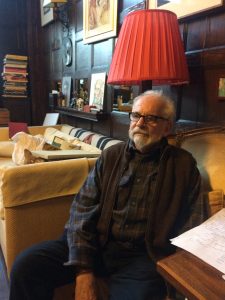
Over the last two weeks I collected a series of conversations with Sigmund Abeles for the Jewish Heritage Oral History Archives, in the Addlestone Library at the College of Charleston. The audio recordings will be available in the future through the Lowcountry Digital Library.
I fist met Sigmund Abeles in the late 1970s. My then wife Vicki Davila and Sig’s then wife Frederike Merck had been room-mates in Pietrasanta, where both had been studying stone-carving with local artigiani. Over the years we have maintained a warm friendship, and shared a great passion for drawing. We both identify with a Northern esthetic–the figurative German and Netherlandish tradition that favors sharp tools and articulate line.
We spoke of his undergraduate days at University of South Carolina, graduate school at Columbia University, fresco-painting at Skowhegan School of Painting and Sculpture and the Art Students League of New York. Unpacking stories about his career as a draftsman, printmaker, painter and sculptor, he described also the perils of being so diversified in an art-market built on backing brands. Abeles taught in a number of colleges and universities, finally retiring from the University of New Hampshire. The conversation mentioned artists whose names today are less well-known; artists such as Leonard Baskin, Michael Mazur, Harold Tovish, Marianna Pineda, Sidney Hurwitz, Hyman Bloom and Rico Lebrun, whom Sig quoted as saying, “If one has nothing to say, they gossip. If one has nothing to draw, they sketch.”
Resisting pressure to work abstractly, or bow to formalist figuration, Sig’s work embraced narrative, social commentary, eroticism and equestrian subjects. Manifested in visual form, as representational imagery, these works represented a departure from his paternal roots in Orthodox Judaism. He discussed his activities within the National Academy of Design, the Century Association, the New York art-world and his beloved children, one of whom–Max Abeles–is making a name for himself as an artist.
Part of our discussion did address his experience of growing up Jewish in Myrtle Beach, South Carolina, his association with the Civil Rights movement that led to his expulsion from the University of South Carolina, standing up to the Klan, and later in life being courted by USC as a Native Son. We spoke of his friendship with Jasper Johns–another South Carolinian, and his first exposure to art at Brookgreen Gardens, which now owns some of his work.
It may come as a surprise that the largest Jewish population in the antebellum United States was not in New York or Philadelphia but in Charleston, followed by New Orleans, Mobile and Savannah. As many as ten thousand Jews saw military service during the Civil War, during which General U.S. Grant ordered all Jews to be expelled from Tennessee, Kentucky and Alabama. Judah P. Benjamin served as Secretary of War and Secretary of State for the Confederacy. Its surgeon-general was Simon Baruch, from South Carolina. The first Jewish governor of any American state was David Emanuel, a captain of militia during the Revolutionary war.
A second interview conducted by Dale Rosengarten, Curator of Special Collections at the College of Charleston, will focus on Sigmund Abeles’s Jewish identity.
The value of collecting these conversations is to preserve the voices and ideas of significant artists like Sigmund Abeles whose creative legacy, despite a distinguished career, might otherwise be forgotten. Artists born in the 1930s, ’40s and ’50s are advancing in years. Many have diminished their output, and have been marginalized by shifting trends in the art-market.
Oral history interviews collected by the College of Charleston, the Archives of American Art, the Senior Artists Initiative in Philadelphia, the Frick Center for Oral History and many other organizations become keystone documents–primary sources for researchers to consult, and from which artists and others might draw inspiration.
James L. McElhinney
 Facebook
Facebook Twitter
Twitter Linkedin
Linkedin